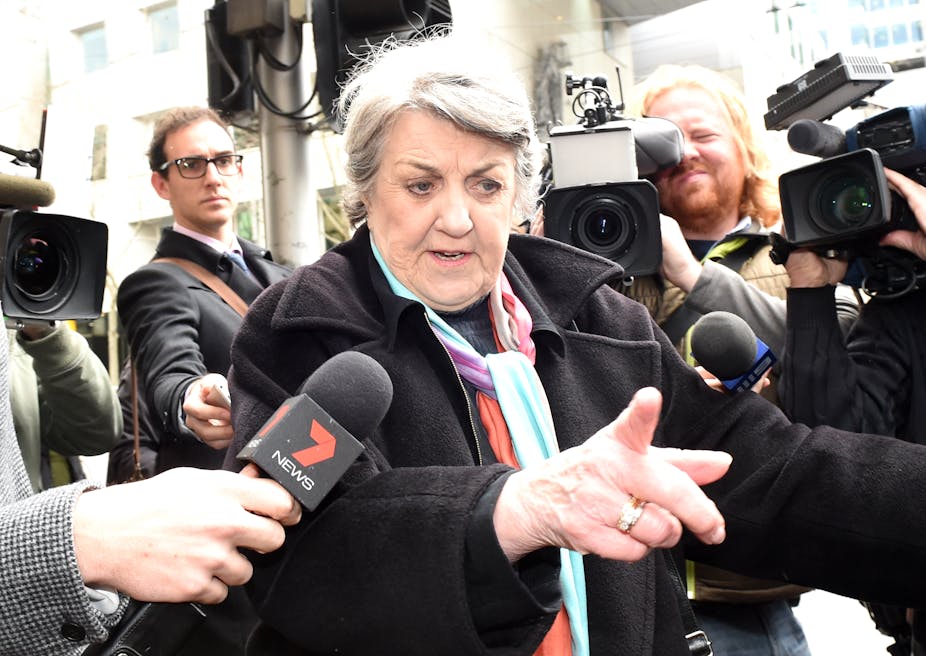Last week, former Prisoner star Maggie Kirkpatrick was found guilty of the abuse of a 14-year-old girl in 1984. Kirkpatrick joins entertainer Rolf Harris and Hey Dad! actor Robert Hughes as the latest Australian celebrity to be convicted of sexual abuse.
These cases raise a murky set of questions about the extent of child sexual abuse and the impunity enjoyed by prominent figures.
The UK has been grappling with these questions since hundreds of people accused entertainer Jimmy Savile of sexual abuse after his death in 2011. He is now recognised as one of Britain’s most prolific sex offenders.
UK police have been investigating an expanding set of scandals regarding the alleged involvement of high-profile men in the sexual abuse of children in the 1970s, 1980s and 1990s. These scandals have now engulfed a number of current and former politicians.
Disclosure is often made later
These allegations of sexual abuse are “historical” in two ways. First, they pertain to incidents of abuse that are often decades old.
Second, it is no exaggeration to say that these allegations are remaking history. These disclosures of abuse challenge our cultural memory and collective understandings of public figures. They tell a more complex and disturbing story than the version of history that we are most familiar with.
Understandably, the credibility and substance of these allegations has come under considerable scrutiny. Why didn’t victims say anything at the time? And is it justified to pursue their allegations now, decades after the fact?
At times, these questions have had a legalistic and sceptical tone to them. They recall entrenched myths that a rape victim who doesn’t raise “hue and cry” immediately after the event is untrustworthy.
An immediate complaint of sexual abuse is relatively unusual. It is more common for children to delay talking about the abuse or to never report it. One retrospective survey of Canadian adults abused as children found that one-fifth reported the abuse within a month, but 58% delayed disclosure for five years or longer, and one-fifth never disclosed the abuse to anyone.
Studies with adult survivors consistently find that most didn’t tell anyone about the abuse when they were kids. Only a small proportion of incidents are ever reported to the authorities.
A long road
Disclosure is not an event but a process. Many factors are at play in enabling or constraining a child to speak directly about abuse and bringing that complaint to the attention of the authorities. The age and development of the child, the relationship of the child to the perpetrator, the severity of the abuse and the availability of support dynamically shape the disclosure process.
Multiple stressors in the child’s family and community context, and social and cultural attitudes that shame and blame victims, can create environments in which disclosure is fraught with difficulty. The process of disclosure often involves behavioural and indirect cues, and accidental disclosures, as much or more often than a conscious decision to tell someone about the abuse.

It is often assumed that disclosing abuse is naturally in the interest of victims. However, children may withhold disclosure because they accurately believe that the adults in their life will be angry with them or not support them.
Research with adult survivors has found that many did disclose in childhood only to experience blame and minimisation. Abuse may then continue in spite of the disclosure.
Negative and shaming reactions to sexual abuse disclosures have been shown to significantly increase the risk of mental illness and distress in the victim. Feeling betrayed is corrosive to mental wellbeing.
In “historical” allegations, the years that elapse between abuse and a court case are often indicative of the long journey that survivors take to recover from abuse and find a forum in which their complaint will be heard. Initial disclosures of abuse are likely to be to friends, partners and other people who the survivor trusts.
In court, the husband of the woman Kirkpatrick abused recalled a conversation in the mid-2000s in which his wife said that, as a teenager, she went to the house of “the nasty one on Prisoner” and “some sexual things happened”. It was several more years before she made a formal complaint.
Even when disclosure occurs in a formal setting – such as to police – survivors are not guaranteed an adequate response. One of Robert Hughes’ victims reported him to police in the late 1980s and again in the 1990s but was apparently told nothing could be done.
The disclosure paradox
The paradox is that, in order to detect sexual abuse, we depend on abused children to speak out, but they are often in environments in which they can’t rely on support or understanding.
In this impossible situation, non-disclosure is a way that victims of abuse protect themselves from further betrayal and harm. Extricating themselves from unsupportive environments and finding opportunities to speak about their abuse is a complex and fragile process that can take many years.
It seems that the pertinent question in “historical” abuse allegations is not:
Why didn’t victims say something at the time?
Rather, it should be:
Why do abuse victims have to wait so long to speak and be heard?
Editor’s note: On December 8, 2015, Maggie Kirkpatrick’s conviction was overturned on appeal.

